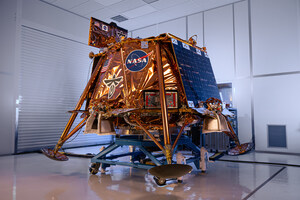WASHINGTON, June 16, 2022 /PRNewswire/ -- NASA will fly two astronaut test pilots aboard the agency's Boeing Crew Flight Test (CFT) mission to the International Space Station, where they will live and work off the Earth for about two weeks.
CFT commander Barry "Butch" Wilmore, whom NASA assigned to the prime crew in October 2020, will join NASA astronaut Suni Williams, who will serve as pilot. Williams previously served as the backup test pilot for CFT while assigned as commander of NASA's Boeing Starliner-1 mission, Starliner's first post-certification mission. As CFT pilot, Williams takes the place of NASA astronaut Nicole Mann, originally assigned to the mission in 2018. NASA reassigned Mann to the agency's SpaceX Crew-5 mission in 2021.
Based upon current space station resources and scheduling needs, a short duration mission with two astronaut test pilots is sufficient to meet all NASA and Boeing test objectives for CFT, which include demonstrating Starliner's ability to safely fly operational crewed missions to and from the space station. To protect against unforeseen events with crew transportation to the station, NASA may extend the CFT docked duration up to six months and add an additional astronaut later, if needed.
NASA astronaut Mike Fincke, whom the agency previously assigned as the Joint Operations Commander for CFT, will now train as the backup spacecraft test pilot and remains eligible for assignment to a future mission. Fincke's unique expertise will continue to benefit the team as he retains his position as flight test lead, filling a vital role in Starliner certification.
"Mike Fincke has dedicated the last nine years of his career to these first Boeing missions and Suni the last seven. Butch has done a marvelous job leading the team as the spacecraft commander since 2020," said Reid Wiseman, chief, Astronaut Office at NASA's Johnson Space Center in Houston. "It was great to see Starliner's successful journey to the International Space Station during the Orbital Flight Test-2 (OFT-2) mission last month. We are all looking forward to cheering on Butch and Suni as they fly the first crewed Starliner mission."
Wilmore, Williams, and Fincke each have flown previously as long-duration crew members aboard the space station.
NASA astronaut Jeanette Epps continues to prepare for an upcoming long duration mission aboard Starliner-1. NASA also has identified backup flight opportunities for Epps on the SpaceX Crew Dragon spacecraft for additional scheduling and resource flexibility. Epps has begun cross-training on the SpaceX Crew Dragon spacecraft to prepare for this possibility.
Meanwhile, NASA and Boeing are continuing to conduct OFT-2 data reviews while assessing future CFT launch opportunities. Following successful completion of the uncrewed OFT-2 mission, the Starliner crew module has returned to Boeing's Commercial Crew and Cargo Processing Facility at NASA's Kennedy Space Center in Florida, where it will undergo system checkouts and vehicle inspections. The Starliner team is in the process of delivering the initial test flight data to NASA and jointly determining forward work ahead of a crewed flight. These engineering and program reviews are expected to continue for several weeks, culminating in a launch schedule assessment at the end of July, based upon spacecraft readiness, space station scheduling needs, and Eastern Range availability.
"Starliner and the Atlas V performed well during all phases of OFT-2, and now we are taking a methodical look at each system to determine what needs to be upgraded or improved ahead of CFT, just as we do with every other crewed flight," said Steve Stich, manager, NASA's Commercial Crew Program. "Additionally, Butch, Suni, and Mike have been instrumental in the development of Starliner on the path to having a second space station crew transportation system."
For the crewed flight test, Boeing's Starliner will launch aboard a United Launch Alliance Atlas V rocket from Space Launch Complex-41 at Cape Canaveral Space Force Station in Florida.
Following a successful CFT mission, NASA will begin the final process of certifying the Starliner spacecraft and systems for crew missions to the space station. Regular, long-duration commercial crew rotation missions enable NASA to continue the important research and technology investigations taking place aboard the orbiting laboratory. Such research benefits people on Earth and lays the groundwork for future exploration of the Moon and Mars, starting with the agency's Artemis missions, which include landing the first woman and first person of color on the lunar surface.
Find out more about NASA's Commercial Crew Program at:
https://www.nasa.gov/commercialcrew
SOURCE NASA

WANT YOUR COMPANY'S NEWS FEATURED ON PRNEWSWIRE.COM?
Newsrooms &
Influencers
Digital Media
Outlets
Journalists
Opted In





Share this article